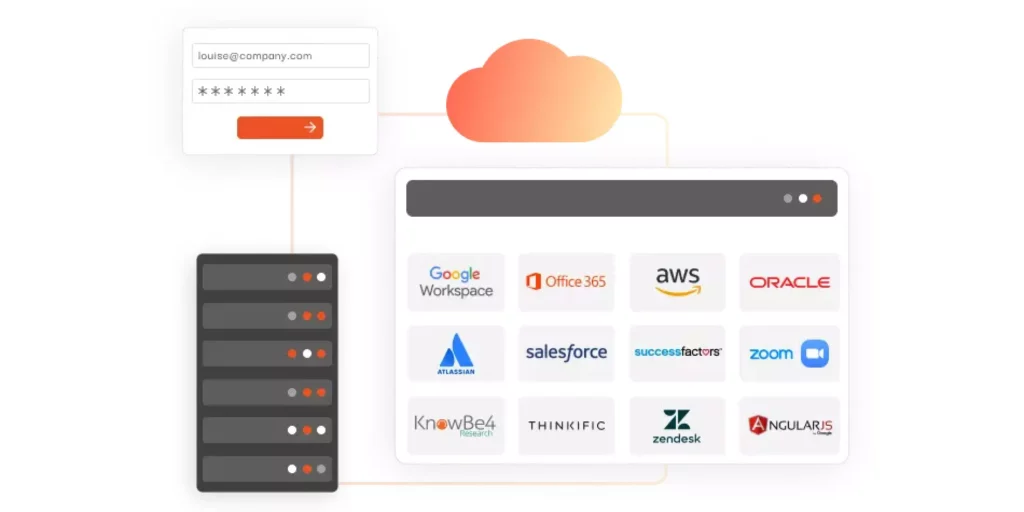Implementing a single sign-on (SSO) solution is one of the best ways to improve security and streamline access management across all your apps and systems. In this post, we’ll explore what SSO authentication is, its key benefits, and best practices for implementation.
What is SSO Authentication and How Does it Work?
SSO, or single sign-on, is a method of access management that allows users to log in once with a single ID and password to gain access to any connected application or system.
With SSO, a central authentication server handles all login requests. Once a user logs in, the SSO server generates an encrypted token that allows seamless access to approved apps without needing to re-enter credentials.
This eliminates the need for multiple logins via different credentials and passwords. Whether accessing email, CRM tools, or internal databases, users can navigate across systems without disruptive login prompts.
How Does the SSO Login Process Work?
The SSO login process typically follows these steps:- User visits the service provider website/app they want to access.
- Service provider redirects user to the identity provider and sends along an authentication request.
- Identity provider checks if user is already logged in. If yes, it skips to step 6.
- If user is not logged in, they are prompted to authenticate with the identity provider’s login screen.
- User enters their credentials (username/password, OTP, etc) which the identity provider validates.
- Identity provider generates a signed token containing the user’s verified identity and sends it back to the service provider.
- Service provider validates the token signature to confirm it came from the trusted identity provider.
- User is seamlessly logged into the service provider’s application.

This allows single sign-on access across all connected applications.
SSO Security Considerations
While SSO improves convenience, it can also pose potential security risks:
- Compromise of the SSO credentials means access to all connected apps. Strong access controls are essential.
- Adding multi-factor authentication provides an extra layer of protection on top of SSO.
- Proper SSO session timeout and token expiration settings help prevent unauthorized access.
- Monitoring user activities and access logs provides visibility into any suspicious behaviors.
SSO Protocols and Standards Overview
Some common SSO protocols and standards include:
- SAML – XML-based protocol used for web SSO scenarios.
- OAuth – Used for mobile, native app SSO. Relies on access tokens.
- OpenID Connect – An authentication layer built on top of OAuth 2.0.
- Kerberos – Provides SSO via ticket granting tickets (TGTs).
- LDAP – Enables centralized user/resource management.
- ADFS – Microsoft’s federated identity management service.
SSO Vendor and Product Comparison
Popular SSO solutions include:
- Okta – Cloud SSO platform with adaptive MFA.
- JumpCloud – Agent-based SSO for managing hybrid IT environments.
- Microsoft ADFS – Active Directory federation services for integrations.
- OneLogin – Cloud identity management with SSO and MFA.
- Auth0 – SSO with support for multiple standards and frameworks.
Evaluate options to find the best fit for your apps, infrastructure, and use cases.
Pros and Cons of SSO
Pros:
- Simple and secure access for users across applications
- Reduced password fatigue
- Streamlined setup and tear-down of user accounts
- Increased productivity and reduced IT tickets
Cons:
- Single point of failure if SSO system goes down
- Access to all apps if credentials are compromised
- Less granular control over access per application
- Upfront implementation time and cost
Why Implement SSO Authentication? Key Benefits
There are several compelling reasons to implement an SSO solution:
Enhanced Security
- Reduces risk associated with multiple passwords and credentials
- Centralized control over access policies and permissions
- Built-in authentication with standards like SAML and OAuth
Increased Productivity
- Eliminates login friction and repetitive credential entry
- Simplifies access for both users and admins
- Enables speedy provisioning and deprovisioning
Streamlined Experience
- Central dashboard for simple, unified access
- Consistent experience across all applications
- Support for both legacy and modern tools
Cost Reduction
- Less help desk tickets for password resets
- Reduced downtime from account lockouts
- Consolidated audit trails and access reporting
Best Practices for Implementing SSO
Follow these best practices when deploying SSO to maximize benefits:
Choose an identity provider – Select a robust platform to serve as the central authentication server. Look for support across all your tools.
Enable just-in-time provisioning – Automate account setup and teardown to boost efficiency.
Enforce multi-factor authentication – Add an extra layer of security on top of SSO.
Educate users – Train employees on the new streamlined access process and enhanced security.
Monitor activity – Use consolidated logs and reporting for visibility into access and behavior.
Automate deprovisioning – Instantly revoke access when employees leave to mitigate risk.
SSO Authentication: Key Takeaways
Implementing SSO provides a more secure and productivity-boosting approach to managing access across an organization’s disparate applications and systems. With a single set of credentials, users can seamlessly authenticate and IT can centralize control.
Ready to evaluate SSO solutions? Contact our experts today for a customized assessment and roadmap.
Frequently Asked Questions (FAQs) About SSO Authentication
Most modern applications support some form of SSO, including Office 365, G Suite, Salesforce, Workday, Slack, and more. SSO providers also support integrating legacy and on-prem applications.
Yes, SSO improves security by centralizing access controls and enabling multi-factor authentication. Leading SSO solutions use encryption and meet security standards. Proper access policies must be implemented.
Yes, SSO provides seamless access across devices including desktops, laptops, tablets, and mobile phones. The user experience remains consistent.
The most common protocols are SAML and OAuth/OpenID Connect. SAML is typically used for web apps while OAuth works for mobile and native apps.
Modern SSO solutions are designed for quick and simple deployment. With the right provider, SSO can be up and running in just days or weeks depending on the number of integrations required.
